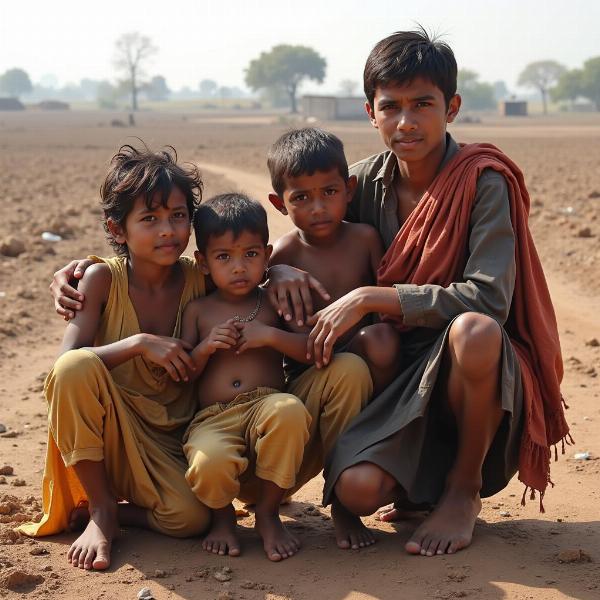Chronic hunger, a persistent and debilitating condition, affects millions worldwide, including a significant portion of the Indian population. Understanding the meaning of chronic hunger in Hindi, along with its causes and consequences, is crucial for addressing this pressing issue. This article delves into the various Hindi terms used to describe chronic hunger, exploring their nuances and cultural significance.
Understanding the Term “Chronic Hunger”
Chronic hunger isn’t simply a feeling of emptiness in the stomach; it’s a prolonged state of inadequate food intake, leading to severe malnutrition and a range of health problems. It’s a constant struggle for survival, impacting physical and mental well-being, and hindering individual and societal progress. In Hindi, the concept of chronic hunger is expressed through various terms, each reflecting different facets of this complex issue.
Common Hindi Translations for Chronic Hunger
Several Hindi words capture the essence of chronic hunger, including:
- दीर्घकालिक भूख (Dirghakalik Bhukh): This translates directly to “long-term hunger” and is the most common and formal term used. It emphasizes the persistent nature of the condition.
- लगातार भूख (Lagatar Bhukh): Meaning “continuous hunger,” this term highlights the unrelenting nature of food insecurity.
- पुराना भूख (Purana Bhukh): This translates to “old hunger,” signifying a long-standing issue deeply rooted in poverty and societal structures.
- अकाल (Akaal): While often translated as “famine,” akaal also carries the connotation of chronic food shortage and widespread hunger.
 Chronic Hunger in India
Chronic Hunger in India
The Impact of Chronic Hunger in India
Chronic hunger has devastating consequences, particularly in developing nations like India. It contributes to:
- Malnutrition: Leading to stunted growth, weakened immunity, and increased susceptibility to diseases.
- Poverty: Creating a vicious cycle that traps individuals and families in a state of perpetual hardship.
- Reduced Productivity: Impacting the workforce and hindering economic development.
- Social Unrest: Food insecurity can exacerbate existing inequalities and lead to social instability.
Addressing the Root Causes
Tackling chronic hunger requires a multi-pronged approach, focusing on:
- Poverty Alleviation: Implementing effective poverty reduction programs and creating economic opportunities.
- Food Security: Ensuring access to affordable and nutritious food through sustainable agriculture and efficient distribution systems.
- Education and Awareness: Promoting awareness about healthy eating habits and the importance of balanced nutrition.
- Empowerment of Women: Recognizing the crucial role women play in food security and providing them with the resources and support they need.
Chronic Hunger vs. Malnutrition
While often used interchangeably, chronic hunger and malnutrition are distinct but related concepts. Chronic hunger refers to the prolonged lack of access to sufficient food, while malnutrition is the resulting condition of nutrient deficiency. Someone experiencing chronic hunger is highly likely to suffer from malnutrition, but not everyone who is malnourished necessarily experiences chronic hunger. For instance, individuals with certain medical conditions or those who make unhealthy food choices can also experience malnutrition.
The Role of Government and NGOs
Government policies and initiatives play a vital role in addressing chronic hunger. These include:
- Public Distribution System (PDS): Providing subsidized food grains to vulnerable populations.
- Mid-day Meal Scheme: Ensuring school children receive at least one nutritious meal a day.
- Integrated Child Development Services (ICDS): Focusing on the nutritional needs of pregnant women, lactating mothers, and young children.
Numerous NGOs also play a crucial role in combating chronic hunger through community-based programs and direct interventions.
Conclusion
Chronic hunger, or दीर्घकालिक भूख, is a complex and pervasive issue with far-reaching consequences. Addressing this challenge requires a collaborative effort from governments, NGOs, and individuals. By understanding the meaning of chronic hunger in Hindi and its various dimensions, we can work together to create a food-secure future for all.
FAQ
-
What is the main difference between chronic hunger and acute hunger? Chronic hunger is a long-term state of food deprivation, while acute hunger is a short-term, severe lack of food often associated with emergencies.
-
How does chronic hunger affect children? Chronic hunger can lead to stunted growth, cognitive impairment, and increased susceptibility to infections in children.
-
What are some of the most effective strategies for combating chronic hunger? Strategies include poverty reduction programs, sustainable agriculture, and improving access to nutritious food.
-
What is the role of education in addressing chronic hunger? Education can empower individuals to make informed choices about nutrition and advocate for their food security.
-
How can I contribute to the fight against chronic hunger? You can support NGOs working on food security, volunteer your time, or donate to relevant causes.
Related Articles
glucose fasting meaning in hindi
Meaning-Hindi.in is a leading provider of professional Hindi translation services, specializing in various fields, from business and legal documents to technical manuals and educational materials. We offer accurate and culturally sensitive translations to bridge the language gap and facilitate effective communication. Our expertise in technical and medical translation ensures precision and clarity for your specific needs. Contact us today for all your Hindi translation requirements. Email: [email protected], Phone: +91 11-4502-7584. Meaning-Hindi.in is your trusted partner for high-quality Hindi translations.